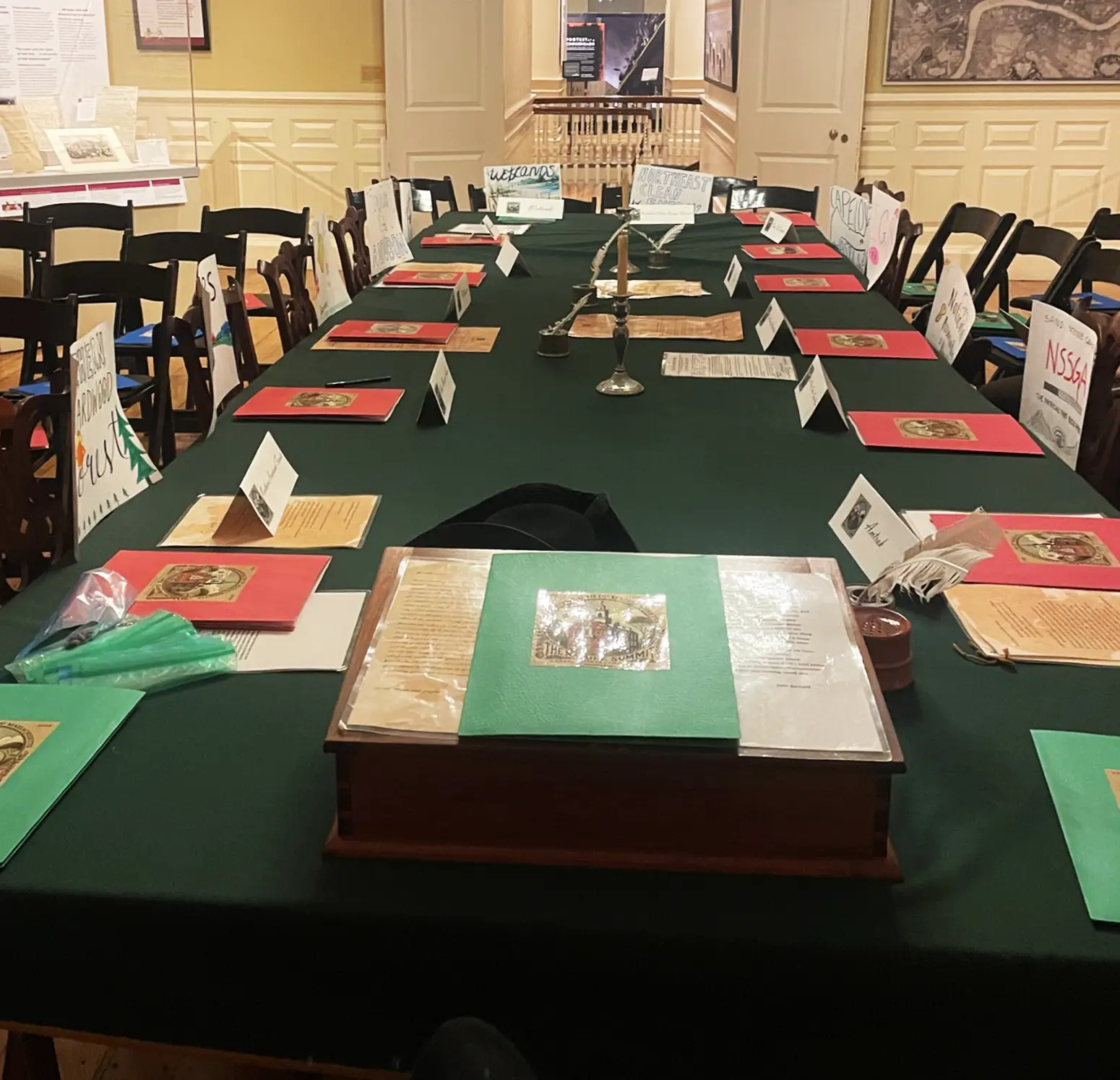Happy is 54 years old, 8,500 pounds, and, notably, an elephant. Nonetheless, in 2018, a group called the Nonhuman Rights Project sued on Happy’s behalf, arguing that she is a legal person (like a corporation or a ship), and therefore should be able to petition for her freedom from the Bronx Zoo. The New York Supreme Court of Appeals ruled against Happy, but what if a constitutional provision allowed Happy to sue for her freedom?
In a new course co-taught by Kemper professor of history Jill Lepore and Smith visiting professor of law James Salzman, students explore the “rights of nature,” culminating in a mock Massachusetts constitutional convention. The decentralized political and legal movement focusing on rights of nature argues that existing environmental law frameworks have failed to protect the planet and that new strategies—like granting animals, plants, and natural features legal personhood—are needed to stave off disaster.
Lepore grew interested in the philosophy after writing about Happy’s suit in The Atlantic. (Happy's suit used some rights of nature arguments but was not a strict rights of nature case). She connected with Salzman at a faculty research workshop and they started designing a class jointly listed in Harvard College and the Law School. Development was supported by Harvard’s Salata Institute, which in 2022 received $200 million for teaching and research on climate and sustainability.
The professors approached the rights of nature movement with curiosity, not sure how to judge the philosophy. Salzman described the existing scholarship on the rights of nature as “bimodal.” “Some folks think it is ‘the legal revolution that could save the planet,’” he said, referencing a 2017 book subtitle, while others say it is “a wrong turn in environmental law.” The course, he emphasized, is “skeptical,” not “rah rah.”
In designing and teaching their course, the pair sought to learn more about the growing movement. It emerged in U.S. circles after a 1972 law review article, “Should Trees Have Standing?,” but it has become much more embedded in Latin American legal systems than in the United States’s. Though several Latin American nations have enshrined rights of nature protections, the few American local ordinances challenged in court have all been struck down—there are even states that have banned rights of nature provisions, Salzman said. “It’s impossible to know right now whether the rights of nature are going to be a legitimate focal point or not 10 years from now,” he said. The course is not the Law School’s first to address natural rights—previous classes have studied animal and wildlife law.
Though the professors are not yet convinced that the rights of nature are the proper way to protect fragile ecosystems, they recognize that students might be searching for new approaches to environmental law. Lepore said that students in the class “don’t think existing environmental law in the U.S. works,” continuing, “Here’s this idea that is far more popular outside the United States than within it. They want to learn about it, and they want to understand it….They don’t necessarily want to adopt it, but they want to use it, to think creatively about how change happens, and to be inspired by the possibility that there are new approaches available.”

After studying a different rights of nature case each week, students completed the course by hosting a mock Massachusetts constitutional convention, the "Nature Summit.” On Monday, December 2, students filed into the Old Massachusetts State House, simulating an effort to amend the world’s oldest continuously operating written constitution in the very place where it was drafted.
Earlier in the semester, students identified 12 stakeholders in Massachusetts natural rights ranging from animals (pigs and pollinators), ecosystems (wetlands, hardwood forests, and the Cape Cod coastline), and humans (Mashpee Wampanoag, mayors, and the Massachusetts Audubon Society) to industries (homebuilding, mining, clean energy, and Amtrak).
Through the summit, the professors hoped to teach their students both about the rights of nature and how to disagree respectfully. Learning by doing helps the classroom become a place “to exercise what are likely somewhat atrophied democratic muscles,” said Lepore, who has utilized simulations in other classes. Delegations prepared for the summit throughout the semester, crafting short videos explaining their core interests, proposing amendments, writing formal defenses of their amendments, and negotiating cross-sector coalitions.
The wide range of interests fostered disagreement. In a class coalition-building exercise, the Amtrak delegation met with more naturally aligned counterparts, trying to pitch a less extreme rights of nature amendment. The three student-delegates talked about their interest in “sustainable development,” supporting “environmental conservation as long as existing rights aren’t abridged,” and not wanting the rights of nature “to infringe our right to develop.” Amendments required a two-thirds majority at the convention, so the industrial and natural groups had to seek compromise.
On the evening of the convention, students came wearing hard hats, butterfly wings, and Lorax mustaches. Though the costumes were silly, the conversation was academic, strictly scaffolded by Robert’s Rules of Order. Soundtracked by the occasional rumble of Orange Line subways, students narrowed down which of the 12 proposed amendments they would seriously consider.
They selected an amendment that granted “vital ecosystems” legal personhood and “the right to existence, flourishing, and restoration.” To sue on the ecosystems’ behalf, the amendment established a “Lorax Board,” which protects, manages, and restores vital ecosystems. Such language spooked the mining delegation, which introduced a new seven-page amendment midway through the summit.
After several rounds of debate and amendments to the amendment, it moved to a final vote. A first pass through the room yielded eight votes, one shy of the threshold for enactment, but the undecided mayoral delegation requested a moment to caucus privately. After some whispered discussion, they held their placard high, passing the amendment.
Though this was the first iteration of the rights of nature class, it will likely not be the last: 42 students enrolled, equally divided between undergraduates and graduate students, and the Law School alone had a 62-student waitlist. The professors are toying with running the class as an uncapped lecture next year to accommodate the demand.
“I couldn’t be more delighted with how this worked out,” Salzman said at the end of the Nature Summit. “You’ve wrestled seriously with these issues. This may turn out to be a new period of environmental law, it may not be. But the things you’re wrestling with are very, very serious.”









